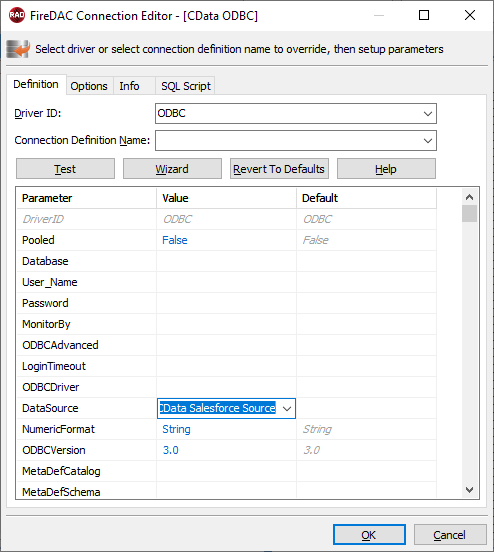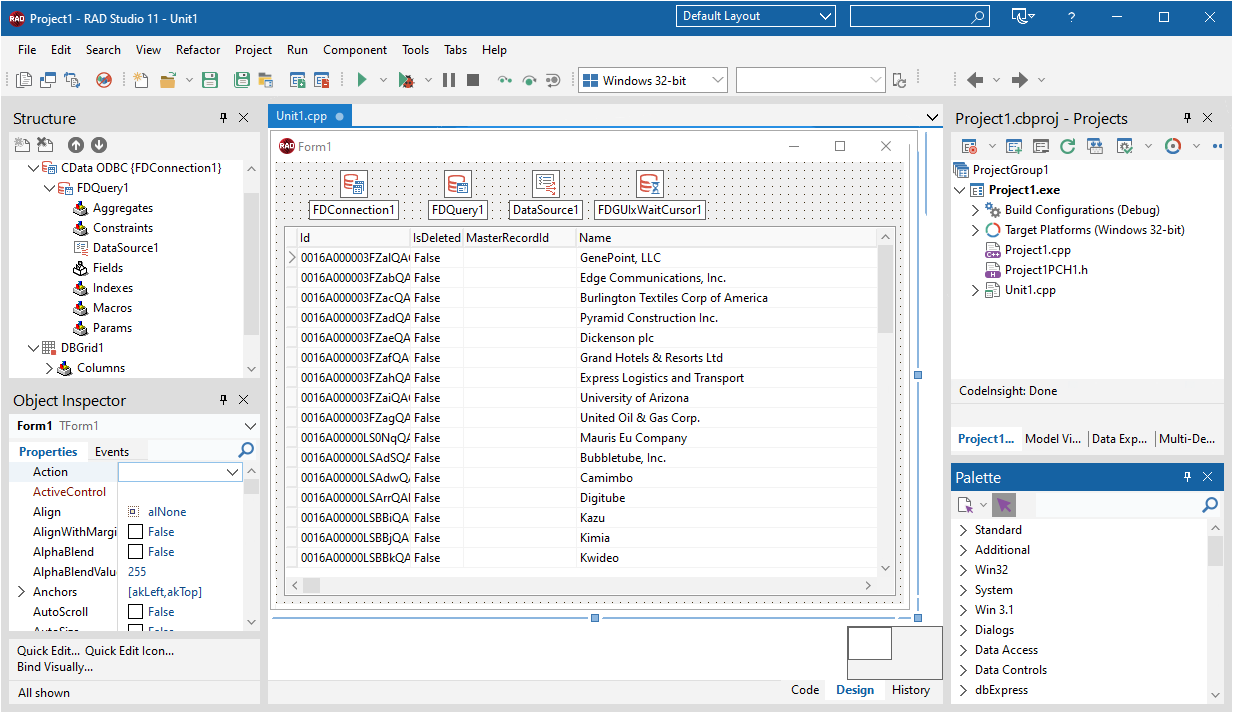各製品の資料を入手。
詳細はこちら →DataBind Controls to Jira Assets データ in C++Builder
DataBind to Jira Assets のデータ in C++Builder with standard components and controls.
最終更新日:2023-06-12The CData ODBC Driver for Jira Assets makes it easy to integrate connectivity to live Jira Assets のデータ with standard data access components in C++Builder. This article shows how to create a simple visual component library (VCL) application in C++Builder that connects to Jira Assets のデータ, executes queries, and displays the results in a grid. An additional section shows how to use FireDAC components to execute commands from code.
Create a Connection to Jira Assets データ
If you have not already, first specify connection properties in an ODBC DSN (data source name). This is the last step of the driver installation. You can use the Microsoft ODBC Data Source Administrator to create and configure ODBC DSNs.
Jira Assets は、APIToken 経由での接続と認証をサポートしています。
API トークンを生成するには:
- Atlassian アカウントにログインします。
- セキュリティ設定 > API トークン > API トークンを作成するをクリックします。
Atlassian がAPI トークンを生成して表示します。
API トークンを生成したら、以下のパラメータをセットします。
- AuthScheme:APIToken。
- User:認証するユーザーのログイン名。
- APIToken:生成したAPI トークン。
これでJira Assets に接続して認証する準備が整いました。
You can then follow the steps below to use the Data Explorer to create a FireDAC connection to Jira Assets.
- In a new VCL Forms application, expand the FireDAC node in the Data Explorer.
- Right-click the ODBC Data Source node in the Data Explorer.
- Click Add New Connection.
- Enter a name for the connection.
- In the FireDAC Connection Editor that appears, set the DataSource property to the name of the ODBC DSN for Jira Assets.

Create VCL Applications with Connectivity to Jira Assets データ
Follow the procedure below to start querying Jira Assets のデータ from a simple VCL application that displays the results of a query in a grid.
-
Drop a TFDConnection component onto the form and set the following properties:
- ConnectionDefName: Select the FireDAC connection to Jira Assets.
- Connected: Select True from the menu and, in the dialog that appears, enter your credentials.
-
Drop a TFDQuery component onto the form and set the properties below:
- Connection: Set this property to the TFDConnection component, if this component is not already specified.
SQL: Click the button in the SQL property and enter a query. For example:
SELECT ID, Name FROM Objects WHERE Label = 'SYD-1'- Active: Set this property to true.
Drop a TDataSource component onto the form and set the following property:
- DataSet: In the menu for this property, select the name of the TFDQuery component.
-
Drop a TDBGrid control onto the form and set the following property:
- DataSource: Select the name of the TDataSource.
- Drop a TFDGUIxWaitCursor onto the form — this is required to avoid a run-time error.

Execute Commands to Jira Assets with FireDAC Components
You can use the TFDConnection and TFQuery components to execute queries to Jira Assets のデータ. This section provides jiraassetsspecific examples of executing queries with the TFQuery component.
Connect to Jira Assets データ
To connect to the data source, set the Connected property of the TFDConnection component to true. You can set the same properties from code:
FDConnection1->ConnectionDefName = "CData Jira Assets ODBC Source";
FDConnection1->Connected = true;
To connect the TFDQuery component to Jira Assets のデータ, set the Connection property of the component. When a TFDQuery component is added at design time, its Connection property is automatically set to point to a TFDConnection on the form, as in the application above.
Create Parameterized Queries
To create a parameterized query, use the following syntax below:
FDQuery1->SQL->Text = "select * from Objects where label = :Label";
FDQuery1->ParamByName("label")->AsString = "SYD-1";
query->Open();
The example above binds a string-type input parameter by name and then opens the dataset that results.
Prepare the Statement
Preparing statements is costly in system resources and time. The connection must be active and open while a statement is prepared. By default, FireDAC prepares the query to avoid recompiling the same query over and over. To disable statement preparation, set ResourceOptions.DirectExecute to True; for example, when you need to execute a query only once.
Execute a Query
To execute a query that returns a result set, such as a select query, use the Open method. The Open method executes the query, returns the result set, and opens it. The Open method will return an error if the query does not produce a result set.
FDQuery1->SQL->Text := "select * from Objects where label = :Label";
FDQuery1.ParamByName("label")->AsString = "SYD-1";
FDQuery1->Open();
To execute a query that does not return a result set, use the ExecSQL method. The ExecSQL method will return an error if the query returns a result set. To retrieve the count of affected rows use the TFD.RowsAffected property.
FDQ.SQL.Text := "delete from Objects where Id = :Id";
FDQuery1->Params->Items[0]->AsString = "x12345";
FDQuery1->ExecSQL();
AnsiString i = FDQuery1->RowsAffected;
Related Articles
Below you can find other articles for using the CData ODBC Driver with RAD Studio, Delphi, and C++ Builder.





